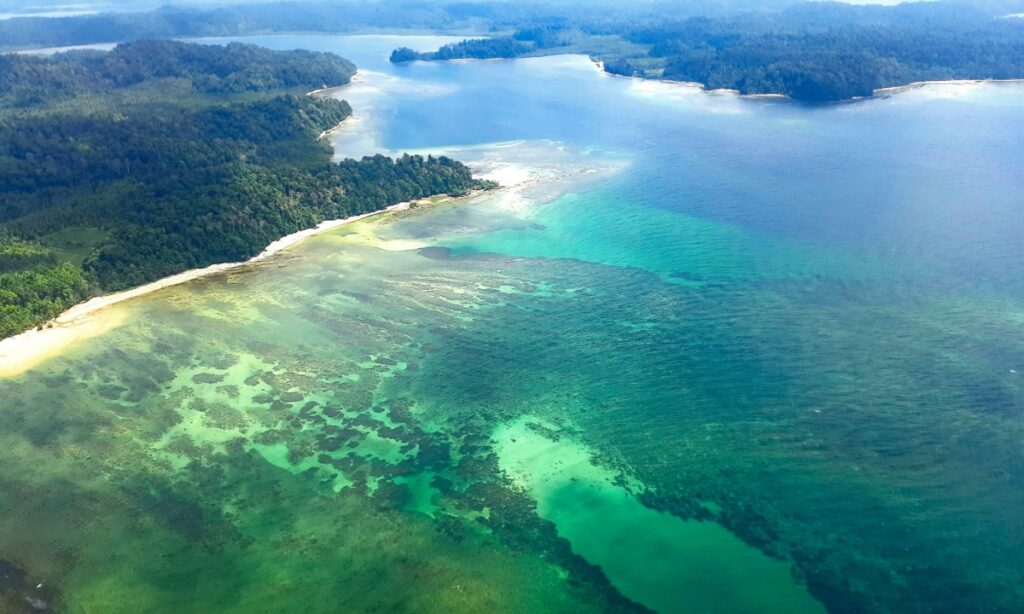First I want to tell you that the featuted photograph is of a drone-shot taken off the coast of Khurma Dera Beach in South Andaman Islands.
The Andaman and Nicobar Islands, situated in the Bay of Bengal, are a captivating tropical island vacation destination known for their pristine beaches, lush greenery, tribal cultures and rich marine biodiversity. Foreign travelers are drawn to these islands to experience their natural beauty and cultural diversity. To facilitate a smooth and enjoyable visit for foreign nationals, the Andaman and Nicobar Islands Administration has established entry guidelines and regulations.
Entry Requirements for the Andaman and Nicobar:
1. Restricted Areas Permit (RAP):
– Previously, foreign nationals visiting the Andaman and Nicobar Islands required a Restricted Areas Permit (RAP) for entry. However, since 2018, the Andaman administration has allowed foreign tourists to enter the islands without RAP.
– As of the latest updates in 2023, foreign tourists can visit 30 islands in the Andaman and Nicobar Islands without the need for a Restricted Areas Permit (RAP). These islands include East Island, North Andaman, Smith Island, and others (full list provided separately).
– For areas not covered by the exemption, foreign nationals still require a Restricted Areas Permit (RAP) to visit specific places in the Andaman and Nicobar Islands.
2. Registration Certificate Issuance:
– Though the foreigners now don’t need RAP to enter Andaman and Nicobar, they must have to Register themselves with the Immigration authorities at arrival in the Airport or Sea Port.
-Upon registration a Certificate will be issued by the administrative authority allowing the foreign tourists to enter Andaman & Nicobar and stay for a duration of maximum 30 days, which can be extended for another 15 days with permission.
– Alternatively, this Registration Certificate can be obtained from Indian Missions Overseas, Foreigner’s Registration Offices at Delhi, Mumbai, Chennai, Kolkata, and Immigration authorities at designated airports in India.
Places in Andaman & Nicobar Open to the Foreign Tourists:
Places Foreigners Can Visit without Restricted Areas Permit (RAP):
Foreigners will not require RAP for visiting the following 30 Islands:
– North Andaman (except tribal reserve areas)
Smith Island
East Island
Curfew Island
Stewart Island
Landfall Island
Aves Island
– Middle Andaman (except tribal reserve areas)
Interview Island
Long Island
Strait Island
North Passage Island
Baratang
– South Andaman (except tribal reserve areas)
Swaraj Dweep (Havelock)
Shaheed Dweep (Neil)
Flat Bay
Viper Island (Day visit only)
– South Sentinel Island (On Andaman Govt. websites it is mistakenly mentioned North Sentinel Island as any entry to the 5 km radius around North Sentinel is strictly prohibited 🚫)
– Little Andaman (except tribal reserve areas)
Chowra
Tillang Chong Island
Teressa
Katchal
– Nancowry Island
Kamorta
Pulomilo
– Great Nicobar Island
– Little Nicobar Island
– Narcondam Island
Places Foreigners Can Visit with Permit in A&N:
According to the Foreigners (Restricted Areas) order of 1963, the Andaman and Nicobar Islands are designated as restricted areas, requiring foreigners to obtain permits from the competent authority for entry or stay.
Places opened for day and night visits:
– All Islands in Mahatma Gandhi Marine National Park (Night Halt in these islands: Boat, Hobday, Twin Islands, Tarmugli, Malay, and Pluto is not allowed and subject to special permission of the UT Admn.)
Islands opened for day visit only:
Cinque Islands
North Reef Island
Point and Paget Islands
Sound Island
Guitar Island
Brother Islands
Sister Islands
– Barren Island – restricted to visit on board vessels only with no landing ashore
These guidelines ensure that foreign tourists can explore specific areas of the Andaman and Nicobar Islands while adhering to the necessary regulations and permit requirements.
Areas Open to the Foreigners for Scuba Diving in Andaman Islands
Scuba diving enthusiasts visiting the Andaman Islands have a plethora of stunning underwater sites to explore. The following areas have been identified and kept open for scuba diving activities:
John & Henry Lawrence Islands (Marine National Park)
Inglis Island (Sanctuary)
Outram Island (Marine National Park)
Campbell Shoal
East Coast of South Andaman Island between North Point and Chidiyatapu, excluding certain specified areas
East and South coasts of Rutland Island outside the Marine National Park
Cinque Island Sanctuary (Marine National Park)
North of North Wandoor and North of Tarmugli Island, excluding certain specified areas
Havelock Island and shallow sites and barren rocks in open sea such as Pilot Reef and Minerva Ledge, excluding specified areas
Long Island
Avis Island
North & South Brother (Wildlife Sanctuary)
Sister Island
Jolly Buoy and Red Skin Island (Marine National Park)
Narcondam Island and Barren Island (no landing ashore)
Regulations and Fees:
- Scuba diving is permitted in the Marine National Park subject to the payment of prescribed fees. The fee is Rs. 500/- per person per day for Indian citizens and Rs. 1000/- per person per day for foreigners.
- Entry to the Marine National Park/Wildlife Sanctuary requires prior permission from the Chief Wildlife Warden, Department of Environment and Forest, Andaman Nicobar Administration, along with the payment of the prescribed fee.
- The list of areas open for scuba diving may be updated periodically, and a negative list will also be notified by the Administration.
Procedure of Obtaining Entry Permit to Protected Areas in Andaman & Nicobar Islands
1. Application Process:
(i) Individuals intending to enter a Sanctuary/National Park, including for scuba diving, must submit Form No. 4 (A) to the Chief Wildlife Warden or an Authorized Officer. Applications can be lodged with the Deputy Conservator of Forests/Divisional Forest Officer/Assistant Conservator of Forests/Range Officer within their respective areas.
(ii) Upon receipt, the Chief Wildlife Warden or Authorized Officer will review the application and may grant or reject it after conducting necessary inquiries.
(iii) Upon approval, an officer authorized by the Wildlife Warden will issue Form No. 4 (B) upon payment of the prescribed fee.
Entry Fee Structure
(i) Marine National Parks and Island Sanctuaries/National Park:
Adults (Indians): Rs. 50/- per person per day
Children (Age 5-12 years) (Indians): Rs. 25/- per person per day
Foreigners: Rs. 500/- per person per day
Foreign Yacht/Ship/Boat: Rs. 1000/- per vessel per day
Indian Boat/Ship: Rs. 500/- per vessel per day
(ii) Other Sanctuary & National Park:
Adults (Indians): Rs. 25/- per person per day
Children (Age 5-12 years) (Indians): Rs. 10/- per person per day
Foreigners: Rs. 250/- per person per day
(iii) Scuba Diving:
Indians: Rs. 500/- per person per day
Foreigners: Rs. 1000/- per person per day
(iv) Students:
Indians: Rs. 5/- per head per day
Foreigners: Rs. 10/- per head per day
These fees are essential for the upkeep and conservation of the natural resources and ecosystems within the protected areas of Andaman & Nicobar Islands.
Guidelines for Foreign Tourists Visiting Andaman & Nicobar Islands
Foreign tourists visiting the open areas in the Andaman & Nicobar Islands must adhere to the following guidelines issued by the Ministry’s circular No.15011/14/91-F.I dated 30.06.92:
i) Accompaniment by Guide: Visiting parties to the Protected areas must need proper permit and also must be accompanied by a guide nominated by the Chief Wildlife Warden of Andaman & Nicobar Islands. It is essential to follow the code of conduct in the park area.
ii) Payment of Entry Fee: Visitors are required to pay an entry fee. Any violation of the National Marine Park Code may result in a suitable fine imposed by the A&N Islands Administration.
iii) Restrictions on Construction: No jetties or permanent structures are allowed to be built upon or off the islands. Barbecue or cooking activities are prohibited. Thatched enclosures made of local materials may serve as toilets, while brick and mortar shelters for shade are not permitted. Lean-to shelters for shade may be allowed.
iv) Restricted Boat Access: Visits to the marine park areas are restricted to small boats or glass bottom boats. Oil leakage is strictly prohibited in the area.
v) Scuba Diving and Photography: Scuba diving and underwater photography are permitted in identified areas. However, removal of coral, fish, or any other item from the Marine Park is strictly prohibited.
vi) Incorporation of Restrictions: Any Restricted Area Permit issued by an agency must incorporate the words “subject to restrictions imposed by the Chief Wildlife Warden, Andaman & Nicobar Islands.”
vii) Regulation of Visits to Mount Harriet and Madhuban: Foreigners visiting Mount Harriet and Madhuban Islands will be regulated by the Andaman & Nicobar Islands Administration in consultation with wildlife representatives in the A&N Islands.
viii) Visits to Volcanic Islands: Foreign tourists may be allowed to visit Barren Island on board vessels, but no landing ashore is permitted. The UT Administration will provide escort to tourists visiting the island. Narcondam Island may be opened to foreign tourists for diving and unescorted day visits.
ix) Restriction on Burmese Nationals: No Burmese national will be allowed to visit Mayabunder and Diglipur without prior permission from the Ministry of Home Affairs.
Adhering to these guidelines ensures a responsible and enjoyable experience for foreign tourists visiting the Andaman & Nicobar Islands.

